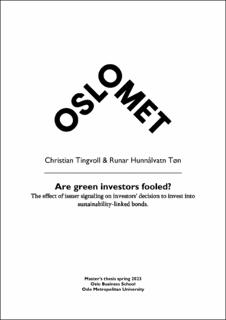Are green investors fooled? The effect of issuer signaling on investors' decision to invest into sustainability-linked bonds.
Master thesis
Published version
Permanent lenke
https://hdl.handle.net/11250/3107739Utgivelsesdato
2023Metadata
Vis full innførselSamlinger
Sammendrag
Sustainability-linked bonds (SLBs) can be used by companies seeking to demonstrate their commitment to environmental improvement (Pears et al., 2023, p.1). However, can investors be confident that issuers signaling their commitment are credible? In our empirical study, we examine the effects of issuer and SLB characteristics. Specifically, we investigate the impact of the U.N. Global Compact commitment, the callable status of SLBs, and the difference between average public listed companies and those with strong ESG scores. Our objective is to understand how these factors influence the probabilities of achieving a predefined key performance indicator (KPIs) and the extent of mispricing observed in SLBs. Our findings indicate that issuers that are not committed to the U.N. Global Compact initiative, issuing non- callable SLBs, and holding strong ESG score achieve higher KPI success rates individually, compared to their counterparts. Furthermore, we compare the investment strategies of unsophisticated green investors, who only invest in issuers committed to the U.N. Global Compact initiative, and sophisticated green investors, who evaluate multiple factors. On average, both types of investors experience high levels of mispricing. While the portfolio of the sophisticated investor achieves a higher KPI success rate of 92%, twice that of the unsophisticated investor. In conclusion, SLB issuers committed to the U.N. Global compact initiative have lower likelihood of achieving their KPI targets, potentially misleading investors with their commitment. Additionally, we document a positive nonlinear relationship between the probabilities of achieving a KPI target and the extent of mispricing of the SLBs.
